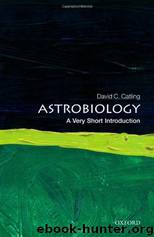Astrobiology_A Very Short Introduction by David C. Catling

Author:David C. Catling [Catling, David C.]
Language: eng
Format: epub
Tags: Science
ISBN: 9780199586455
Goodreads: 17841723
Publisher: Oxford University Press, USA
Published: 2013-09-27T00:00:00+00:00
An inside view of terrestrial life: the cell
We have just considered biology on a global scale but under the microscope all organisms are composed of cells of different types that put them into one of three domains, the Eukarya, Archaea, or Bacteria. The last two are microbial and are sometimes lumped together as prokaryotes, although many microbiologists now consider this term antiquated because archaea and bacteria are biochemically dissimilar. DNA floats freely in the middle of the archaeal and bacterial cells, whereas in eukaryotes the DNA is housed inside a membrane-bound nucleus. Archaea and bacteria are single cells, with the exception of some bacterial species that join up in a row to form filaments. Eukaryotes can be single celled, such as an amoeba or a baker’s yeast, but only eukaryotes form large, three-dimensional multicellular organisms, such as mushrooms or humans.
The classification into three domains of life was motivated by genetics and supersedes an older ‘five kingdom’ system of plants, animals, fungi, protists (single-celled eukaryotes), and bacteria. However, these old terms are still used in taxonomy, which classifies an organism below its domain according to Kingdom, Phylum, Class, Order, Family, Genus, and Species. The mnemonic I use to remember these levels (or taxa) is far too rude to mention but another is ‘Keeping Precious Creatures Organized For Grumpy Scientists’. The taxonomic levels of a human, for example, are the animal kingdom, chordate phylum, mammal class, primate order, hominid family, Homo genus, and sapiens species. The Swedish botanist Carolus Linnaeus (1707–78), who gave us the word biology, developed modern taxonomy, including binomial names for organisms, e.g. Homo sapiens. But it took the advent of evolutionary theory and molecular biology to uncover the biochemical unity of life and genetic common ancestry.
While there are some similarities between eukaryotes and the other two domains, there’s also a gulf in complexity. Bacteria and archaea are usually around 0.2–5 microns (millionths of a metre) in size, with rare exceptions, whereas eukaryotic cells are generally bigger, at 10–100 microns size. The larger eukaryotic cells contain organelles to perform specialized functions, analogous to the organs of the human body (Fig. 4). For example, the mitochondria carry out respiration. In plant or algal cells, chloroplasts perform photosynthesis. However, one feature common to all cells is a large number of ribosomes, which are globular structures that make proteins. For example, in prokaryotes or simple eukaryotes such as yeast, the cell might have several thousand ribosomes, while in an animal cell the number might reach several million.
Download
This site does not store any files on its server. We only index and link to content provided by other sites. Please contact the content providers to delete copyright contents if any and email us, we'll remove relevant links or contents immediately.
Sapiens: A Brief History of Humankind by Yuval Noah Harari(14216)
Sapiens by Yuval Noah Harari(5281)
Pale Blue Dot by Carl Sagan(4886)
Homo Deus: A Brief History of Tomorrow by Yuval Noah Harari(4801)
Livewired by David Eagleman(3663)
Origin Story: A Big History of Everything by David Christian(3632)
Brief Answers to the Big Questions by Stephen Hawking(3358)
Inferior by Angela Saini(3260)
Origin Story by David Christian(3133)
Signature in the Cell: DNA and the Evidence for Intelligent Design by Stephen C. Meyer(3055)
The Gene: An Intimate History by Siddhartha Mukherjee(3029)
The Evolution of Beauty by Richard O. Prum(2925)
Aliens by Jim Al-Khalili(2776)
How The Mind Works by Steven Pinker(2714)
A Short History of Nearly Everything by Bryson Bill(2616)
Sex at Dawn: The Prehistoric Origins of Modern Sexuality by Ryan Christopher(2472)
From Bacteria to Bach and Back by Daniel C. Dennett(2432)
Endless Forms Most Beautiful by Sean B. Carroll(2414)
Who We Are and How We Got Here by David Reich(2385)
